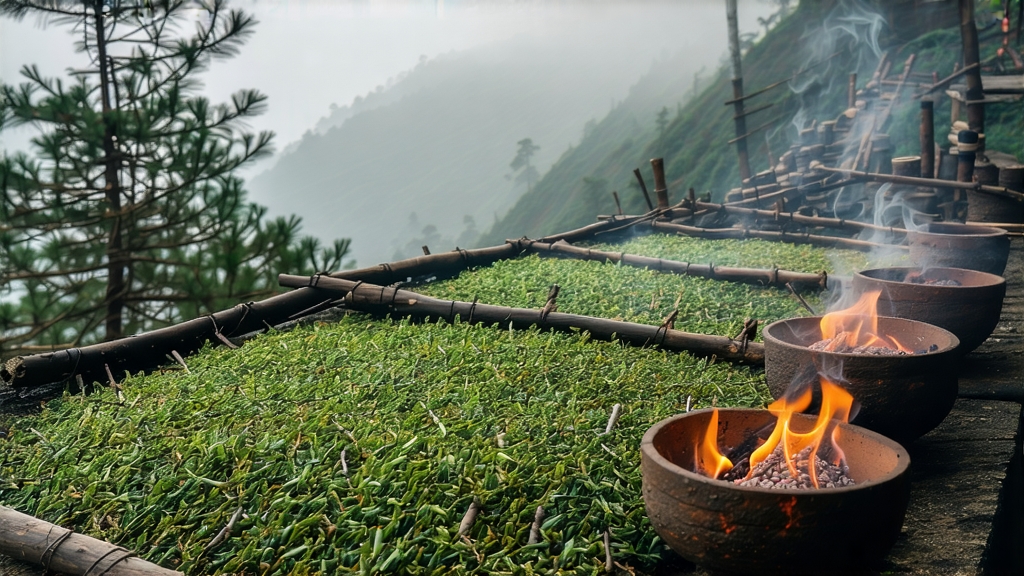
Ask most tea lovers to name the oldest black tea on earth and they will answer, almost instinctively, Lapsang Souchong. Born in the precipitous Wuyi Mountains of northern Fujian around the late Ming dynasty, this “Zheng Shan Xiao Zhong” is not merely a beverage; it is a time capsule of Chinese ingenuity, maritime trade, and the moment when green tea ceded part of its throne to the newly oxidised leaf that Europe would later call “black.”
The origin story is as smoky as the tea itself. In 1646, Qing troops pressed southward; villagers, fleeing the chaos, left freshly picked leaves overnight. By morning the leaves had reddened. To salvage the crop and accelerate drying, they rushed the leaves over resinous pine fires. The result was a tea that tasted of longan, honey and campfire—an accidental masterpiece that travelled on Dutch and British ships to London coffeehouses, where it became the prototype for every breakfast blend that followed.
Geography stamps the leaf indelibly. The core “zheng shan” (original mountain) micro-zone lies inside the 60 km² Wuyi National Nature Reserve, a UNESCO dual heritage site where granitic peaks thrust through a subtropical cloud belt. Diurnal temperature swings of 15 °C slow growth, concentrating amino acids and sugars. The soil is a coarse, mineral-rich laterite strewn with weathered volcanic tuff; drainage is so sharp that roots plunge three metres in search of water, absorbing manganese and potassium that later translate into a shimmering, sweet cup. Only leaf plucked within this radius may legally bear the name “Zheng Shan Xiao Zhong”; everything else is “wai shan” (outside mountain) and lacks the perfume of resin and rock.
Three sub-styles now coexist. Traditional Lapsang is withered over pine embers, rolled, fully oxidised, then smoked a second time in wooden chambers called “qing lou.” The smoke is gentle, a cool 30 °C updraft that lacquers the leaf with guaiacol and syringol, molecules that read as bacon and incense to the human palate. A newer, unsmoked “Zheng Shan Xiao Zhong” emerged in 2005 for the domestic market: the same cultivar—typically the small-leaf “cai cha” or the hardy “xiao ye zhong”—is withered on bamboo trays above hot-air ducts, yielding a malt-forward liquor reminiscent of caramelised sugar and dried longan. Between these poles sits “ban xun” (half-smoked), a compromise that receives only the initial ember kiss, softer on nose yet still resonant in cup.
Crafting the classic smoked version is choreography of wood, wind and timing. Picking opens the drama at dawn on the first clear day after the Grain Rain festival. Two leaves and a bud, still dew-beaded, are delivered to the factory within the hour. Withering happens in a second-floor loft where pine logs smoulder in shallow pits; the leaf loses 65 % of its moisture while inhaling smoke. When the edges feel parchment-dry and the centre remains leather-tough, workers roll the leaf for 45 minutes on rattan mats, bruising cells to invite oxidation. The leaf is then heaped in aluminium trays inside a humid “fa jiao” room kept at 26 °C and 85 % RH; colour shifts from jade to copper over three hours. Finally comes the signature re-firing: the tea is spread on sieves slid into multi-tiered pine chambers. Fresh resinous boards from 40-year-old Masson pines are lit; the smoke is ducted sideways so it drifts, never scorches. After six hours the leaf is jet-black, glossy, and carries 3–5 % moisture—ready to rest for a month so smoke and tea marry in equilibrium.
Water is the unseen ingredient. At the Wuyi workshop they insist on mountain spring water with 30–50 ppm TDS and a neutral pH. For the gongfu ritual, 5 g of leaf nestles in a 120 ml zisha teapot pre-warmed to erase any clay chill. The first 5-second rinse is discarded; it is purely aromatic, a courtesy to the guest. Subsequent infusions begin at 85 °C for 10 seconds, escalating by 5 seconds each round. A dozen infusions are possible